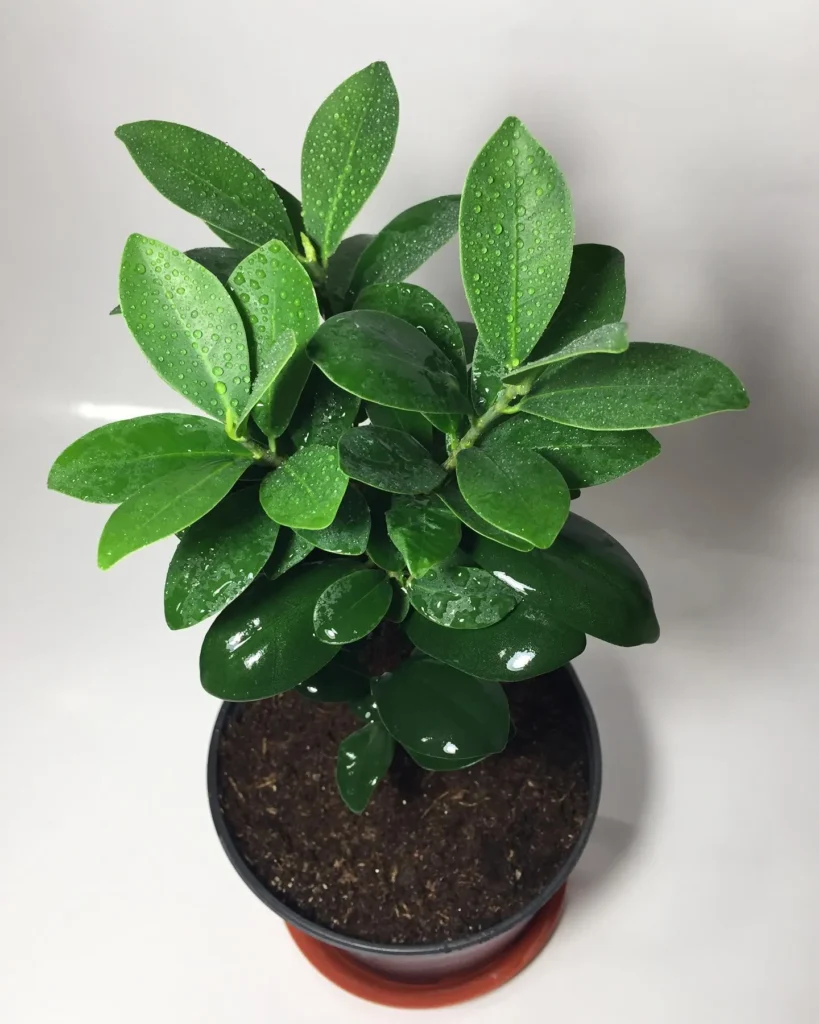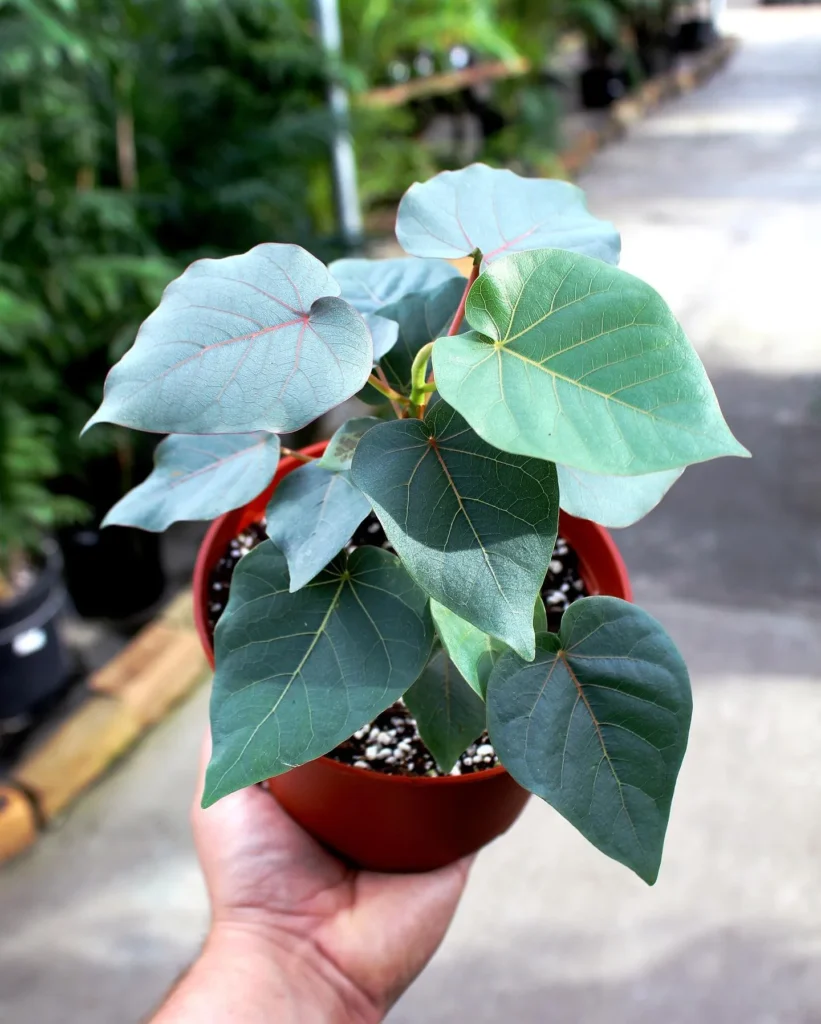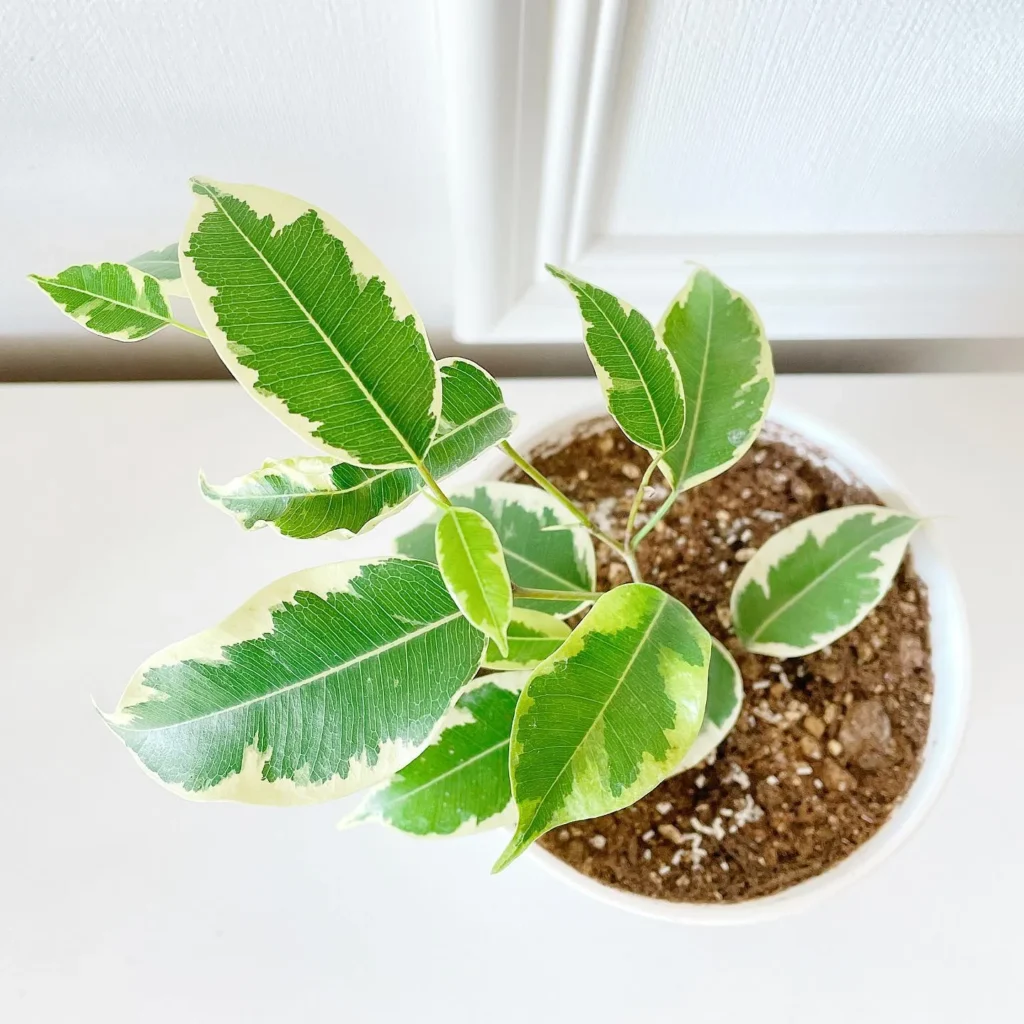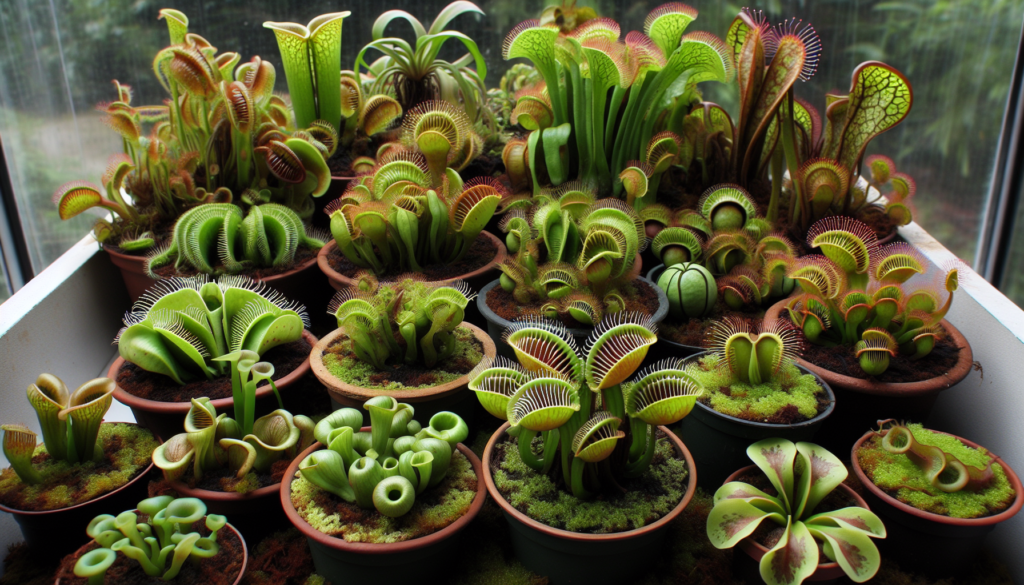To propagate a Ficus, cut a 4-6 inch stem section just below a leaf node, remove the lower leaves, dip the cut end in rooting hormone, and plant in moist soil, keeping it warm and humid until roots develop.
This guide equips gardeners with techniques for Ficus propagation, involving methods like stem cuttings, air layering, or seed germination, each with unique advantages. Whether you’re a novice or seasoned gardener, this journey offers insights into multiplying Ficus plants, highlighting propagation’s role in expanding your plant collection.
Choosing the ideal Ficus variety for propagation
When it comes to propagating Ficus plants, not all varieties are created equal. Choosing the right Ficus variety is crucial to ensure successful propagation and achieve the desired results.
In this section, I will walk you through different Ficus varieties that are known to propagate well and discuss their specific requirements and characteristics.
By selecting the ideal Ficus variety for propagation, you will be setting a solid foundation for the propagation process and increasing your chances of success. Let’s explore some popular Ficus varieties that you can consider:
- Ficus benjamina: This popular variety, also known as the Weeping Fig, is commonly propagated through stem cuttings. It thrives in bright, indirect light and requires regular watering to maintain its moisture levels.
- Ficus elastica: The Rubber Tree is another popular Ficus variety suitable for propagation. It can be propagated through stem cuttings and is known for its large, glossy leaves. Ensure it receives sufficient bright light and moderate watering.
- Ficus lyrata: The Fiddle-Leaf Fig is a trendy choice for indoor plant enthusiasts. It can be propagated through stem cuttings and prefers bright, indirect light. Care should be taken to avoid overwatering.
Preparing your Ficus plants for propagation

Before you embark on the exciting journey of propagating your Ficus plants, it is essential to prepare them properly. Adequate preparation plays a crucial role in ensuring successful propagation.
Here are some essential tips to help you prepare your Ficus plants for propagation:
Choosing the right time
Timing is crucial when it comes to propagating Ficus plants. It is best to choose a time when the plants are in their active growth phase, usually during the spring or early summer.
During this time, the plants are more likely to develop new roots and establish themselves successfully.
Inspecting the health of your plants
Before propagating your Ficus plants, it is important to check their overall health. Look for signs of disease, pests, or any other issues that could affect the success of propagation.
Ensure that you choose healthy parent plants for taking cuttings or using other propagation methods.
Preparing the cuttings
When taking stem cuttings from your Ficus plants, make sure to use clean and sharp pruning shears. Select stems that are healthy and free from any damage or disease.
It is recommended to take cuttings that are 3 to 4 inches long, with at least two sets of leaves.
Using a well-draining potting mix
Prepare a well-draining potting mix that is suitable for Ficus plants. A mix of peat moss and perlite or vermiculite works well. Avoid using heavy soils that may retain too much moisture and lead to root rot.
Ensure that the potting mix is moist but not saturated.
Providing the right amount of light
Ficus plants thrive in bright, indirect light. Place your cuttings in a location where they can receive bright, filtered light throughout the day. Avoid exposing them to direct sunlight, as it can cause leaf burn and hinder root development.
Patience and care
Successful propagation requires patience and regular care. Monitor the moisture levels in the potting mix and water your cuttings as needed to keep the soil lightly moist.
Avoid overwatering, as it can lead to rotting. Also, be patient with the rooting process, as it can take several weeks for new roots to develop.
Propagation of Ficus through stem cuttings

Stem cuttings are a tried and true method for propagating Ficus plants. By following a few simple steps, you can successfully grow new Ficus plants from healthy stem cuttings.
Here’s a step-by-step guide to help you get started:
Gather your materials
Before you begin taking stem cuttings, gather the necessary materials. You’ll need a clean pair of pruning shears, a small container filled with water or a rooting hormone solution, a well-draining potting mix, and a container for planting the cuttings.
Select the right cutting
Choose a healthy stem from your Ficus plant to take the cutting. Look for a stem that is about 4-6 inches long and has several sets of leaves. Make sure the stem is disease-free and free from any signs of damage or decay.
Make the cut
Using the pruning shears, make a clean cut just below a node on the selected stem. A node is where the leaf meets the stem. Aim for a diagonal cut to provide a larger surface area for root development.
Prepare the cutting
Remove any leaves from the lower half of the cutting, leaving only a few at the top. This helps reduce water loss and directs energy towards root development. If desired, dip the cut end of the stem into a rooting hormone to enhance root growth.
Plant the cutting
Fill a small container with a well-draining potting mix. Using your finger or a pencil, create a hole in the soil and gently insert the cutting. Make sure the soil is firm around the cutting to provide stability.
Water the cutting thoroughly to settle the soil and ensure good contact between the cutting and the growing medium.
Provide the right conditions
Place the container in a warm and well-lit area, out of direct sunlight. Maintain a consistent level of moisture in the soil by misting it regularly or covering the container with a plastic bag to trap humidity.
Avoid overwatering, as it can lead to root rot.
Monitor and care for the cutting
Keep a close eye on the cutting and monitor its progress. Within a few weeks, you should start to see new growth indicating successful root formation.
Once the root system is established, you can transplant the cutting into a larger pot with well-draining soil, continuing to provide it with proper care and maintenance.
Air layering as a method for Ficus propagation

Air layering is an advanced propagation technique that allows you to create new Ficus plants by inducing root growth on a section of the plant while it is still attached to the parent plant.
This method is particularly useful for Ficus plants that are difficult to propagate through other means, such as stem cuttings. It allows you to reproduce plants that have desirable characteristics, ensuring that the new plants retain the same traits as the parent plant.
To perform air layering on a Ficus plant, follow these steps:
- Identify a healthy and mature branch on the Ficus plant that you wish to propagate.
- Make a small incision in the middle of the branch, ensuring that it is deep enough to penetrate the bark and expose the inner layers of the stem.
- Apply a rooting hormone to the exposed area to stimulate root growth.
- Wrap the exposed area with damp sphagnum moss, ensuring that it covers the entire area.
- Wrap the moss-covered area with plastic wrap, sealing it tightly to create a humid environment for root development.
- Secure the plastic wrap with twine or tape to keep it in place.
- Monitor the air layer regularly, ensuring that the moss remains moist and there is sufficient humidity.
- After some time, usually several weeks to a few months, roots will start to develop from the exposed area.
- Once the roots have grown to a sufficient length, carefully cut below the air layering to remove the newly rooted section from the parent plant.
- Plant the new Ficus plant in a suitable pot or container, using well-draining soil.
- Provide the newly propagated Ficus plant with the appropriate care, including watering, sunlight, and fertilization, to help it establish and thrive.
Propagation of Ficus from seeds
Propagating Ficus plants from seeds is a fascinating journey that allows you to witness the entire life cycle of these beautiful plants. While it requires more time and patience compared to other propagation methods, the rewards are well worth it.
In this section, I will guide you through the process of collecting and preparing Ficus seeds, creating optimal conditions for germination, and nurturing the seedlings through their initial growth stages.
Collecting Ficus seeds
The first step in propagating Ficus from seeds is to collect mature seeds from a healthy Ficus plant. Look for mature fruits on your Ficus tree or houseplant.
Once the fruits have ripened and turned a deep color, carefully extract the seeds from the flesh of the fruit.
Preparing Ficus seeds for germination
After collecting the seeds, it is crucial to prepare them properly for germination. Begin by cleaning the seeds to remove any sticky residue or pulp that may inhibit germination.
You can gently rinse the seeds with water or use a damp cloth to wipe them clean.
Creating optimal conditions for germination
Germinating Ficus seeds successfully requires specific conditions. Start by filling a seed tray or small pots with a well-draining seed-starting mix. Place the seeds on top of the soil, spacing them out evenly.
Lightly press the seeds into the soil, ensuring good seed-to-soil contact without burying them too deeply.
Next, mist the seeds and soil with water to ensure they remain slightly moist but not waterlogged. Cover the tray or pots with a transparent plastic lid or wrap them in a plastic bag to create a humid environment.
Keep the tray or pots in a warm location with indirect sunlight, maintaining a temperature between 70°F and 80°F (21°C to 27°C).
Nurturing the seedlings through the initial growth stages
Over the next few weeks, you will begin to see the Ficus seedlings emerge from the soil. As soon as the seedlings have a few sets of true leaves, it is time to provide them with more light.
Move the tray or pots to a bright location with indirect sunlight or use grow lights to ensure they receive adequate illumination.
Continue to water the seedlings regularly, ensuring the soil remains slightly moist. As the seedlings grow, you can gently transplant them into larger pots, using a well-draining potting mix. Be careful not to disturb the delicate roots.
Caring for newly propagated Ficus plants

Successfully propagating Ficus plants is only the beginning. Once you have established new plants, it is crucial to provide them with the care they need to thrive.
The proper care practices for newly propagated Ficus plants will ensure their healthy growth and development as they adapt to their new environment.
Watering
Proper watering is crucial for the health of newly propagated Ficus plants. Keep the soil moist but not overly saturated. Check the moisture level by inserting your finger into the soil up to the knuckle.
If it feels dry, water the plant until the water drains out of the bottom of the pot. Avoid waterlogging, as excessive moisture can lead to root rot.
Fertilizing
Young Ficus plants require regular fertilization to provide them with essential nutrients for growth. Use a balanced liquid fertilizer, diluted to half-strength, once a month during the growing season.
Be careful not to over-fertilize, as this can cause nutrient burn and damage the plants. Always follow the recommended dosage on the fertilizer label.
Adjusting growing conditions
During the initial stages of growth, newly propagated Ficus plants may need adjustments to their growing conditions. Ensure they receive adequate sunlight, as most Ficus varieties require bright, indirect light.
Avoid placing them in direct sunlight, as it can scorch the leaves. If the plants show signs of stress or wilting, consider adjusting their placement or providing additional shade.
Monitoring for pests and diseases
Keep a close eye on your newly propagated Ficus plants for any signs of pests or diseases. Common pests that can affect Ficus plants include spider mites, aphids, and scale insects.
Regularly inspect the leaves and stems for any signs of pests or damage. If necessary, treat the plants with appropriate organic or chemical pest control methods.
Troubleshooting common Ficus propagation problems
Propagating Ficus plants can be a rewarding experience, but it doesn’t always go smoothly. Even with careful attention, complications can arise.
In this section, I will address common issues that may occur during Ficus propagation and provide you with troubleshooting tips to help you overcome them.
One common problem that arises is root rot, which can be caused by overwatering or poor drainage. To prevent root rot, make sure your Ficus plants are potted in well-draining soil and avoid overwatering.
If you notice signs of root rot, such as wilting leaves, browning roots, or foul odor, take immediate action by removing the affected parts and adjusting your watering practices.
Another issue that may occur is fungal diseases, such as powdery mildew or leaf spot. These diseases can weaken the plant and hinder its growth.
To prevent fungal infections, maintain good air circulation around your Ficus plants, avoid overhead watering, and provide adequate spacing between plants. If you notice any signs of fungal diseases, such as white powdery patches or dark spots on the leaves, treat the plants with appropriate fungicides and adjust your watering schedule.
Lastly, Ficus plants might show stunted growth or yellowing leaves, indicating a nutrient deficiency. To address this issue, provide your plants with a balanced fertilizer specifically formulated for Ficus plants.
Follow the instructions on the fertilizer packaging to avoid overfeeding, which can cause fertilizer burn. Regularly monitor the growth and appearance of your plants to ensure they are receiving the necessary nutrients.













